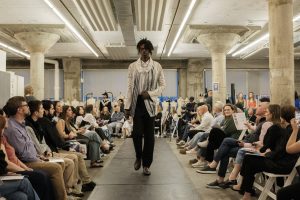Syracuse senior confronts inherited trauma through painting
SU senior confronts inherited trauma through painting
A soft hum of music emanates from one side of a circular studio overlooking Syracuse University’s quad. Huge canvasses are strewn around next to tables filled with old pictures, books and napkins caked with paint. A late afternoon golden light streams in from the tall windows. Leito Navarrete moves back and forth from a makeshift pallet where he mixes colors to a canvass where he paints a group of children.
A senior at Syracuse University studying studio arts, Navarrete spends many afternoons just like this: quietly painting his senior thesis as the sun dips behind the Carrier Dome. In doing so he is confronting a personal topic: inheritance of generational trauma and religious dogmas.
Having grown up a gay man in a deeply religious Christian family, Navarrete pours his own experience struggling with religion into the subjects he paints.
“I think one of the things that he embodies is courage,” SU studio arts associate professor Susan D’Amato said. “He is delving into areas in his own experience and also human experience that requires a kind of commitment and courage, and I respect that about him.”
D’Amato attended a student exhibition in 2018 and found herself drawn to one set of drawings by Navarrete, then a recent transfer to SU. She could trace the marks on the piece, and she was impressed by the integration of form and space.
“You don’t normally see that quality in a student so young,” said D’Amato, who wanted to know more about the artist.
“You really need to meet Leito,” D’Amato remembers one of her colleagues telling her that night.
D’Amato is now one of the professors offering guidance and feedback to Navarrete as he works on his Senior thesis. She said he has made incredible strides, and has spent time experimenting, researching and reflecting on what’s important to him.
Navarrete bases his work on old photographs of him and his family. He looks through archival materials for inspiration and proceeds to draw figures in charcoal. The figures that emerge are abstracted versions of real people, representing a removal from his own childhood traumas related to his sexuality.
“It’s really like a self-portrait, this thesis,” says Navarrete, “Because I am using figures that are not of my own body, they are other people, but I see myself invested in these figures too.”





